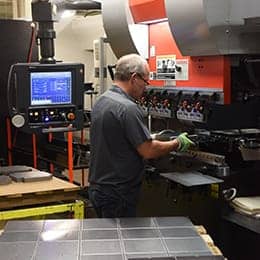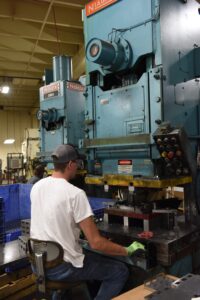The impact on steel, stainless, copper and aluminum material cost increases are affecting companies throughout the supply chain. Shortages are consistent across all forms: coil, bar, rod, tube and sheet. This month, material suppliers are implementing price increases as well as surcharges.
 CNC Laser cutting of metal with sparks, modern industrial technology. Small depth of field.[/caption]
CNC Laser cutting of metal with sparks, modern industrial technology. Small depth of field.[/caption]We are seeing a convergence of factors affecting the pricing of raw materials. Due to Covid-19, material prices took a dip in summer of 2020. Hot-rolled steel dropped roughly 10% during the summer as plants halted production and supply rose.
When industry activity returned, the excess supply was consumed. Replenished supply was slow to enter the market, however. This had a whipsaw effect as manufacturing activity rose quickly. According to the JP Morgan Global Manufacturing PMI, global manufacturing activity increased to 53.0 in October making it the highest in 29 months. Additionally, the steel market has been impacted by scheduled mill maintenance shutdowns and a few unscheduled outages caused by equipment failures.
Regarding aluminum, the tariffs that were implemented to combat imported aluminum dumping have not abated. Back on October 9th, 2020, the U.S. Department of Commerce announced another round of tariffs driving price upward.
CNC Laser cutting of metal with sparks, modern industrial technology. Small depth of field.[/caption]
CNC Laser cutting of metal with sparks, modern industrial technology. Small depth of field.[/caption]We are seeing a convergence of factors affecting the pricing of raw materials. Due to Covid-19, material prices took a dip in summer of 2020. Hot-rolled steel dropped roughly 10% during the summer as plants halted production and supply rose.
When industry activity returned, the excess supply was consumed. Replenished supply was slow to enter the market, however. This had a whipsaw effect as manufacturing activity rose quickly. According to the JP Morgan Global Manufacturing PMI, global manufacturing activity increased to 53.0 in October making it the highest in 29 months. Additionally, the steel market has been impacted by scheduled mill maintenance shutdowns and a few unscheduled outages caused by equipment failures.
Regarding aluminum, the tariffs that were implemented to combat imported aluminum dumping have not abated. Back on October 9th, 2020, the U.S. Department of Commerce announced another round of tariffs driving price upward.
 Understandably, there is uncertainty about the future of the supply chain. There is speculation that the new administration will lift tariffs to increase the supply into the market in an effort to meet the surge in demand. It is unclear, however, what effect this will have on the market and how quickly it can level out. Additionally, shuttered steel mill lines will be back online backfilling the supply, led by new mills in Arkansas and Texas that will help boost supply over the next two years.
Pent up demand for product from the 2020 Covid-19 challenges has plants working to fill orders into Q1 2021. Although there is price and availability relief in sight, it’s more likely to see a slower rebound leading into spring 2021.
Understandably, there is uncertainty about the future of the supply chain. There is speculation that the new administration will lift tariffs to increase the supply into the market in an effort to meet the surge in demand. It is unclear, however, what effect this will have on the market and how quickly it can level out. Additionally, shuttered steel mill lines will be back online backfilling the supply, led by new mills in Arkansas and Texas that will help boost supply over the next two years.
Pent up demand for product from the 2020 Covid-19 challenges has plants working to fill orders into Q1 2021. Although there is price and availability relief in sight, it’s more likely to see a slower rebound leading into spring 2021.
WHY IS THIS HAPPENING?
 CNC Laser cutting of metal with sparks, modern industrial technology. Small depth of field.[/caption]
CNC Laser cutting of metal with sparks, modern industrial technology. Small depth of field.[/caption]We are seeing a convergence of factors affecting the pricing of raw materials. Due to Covid-19, material prices took a dip in summer of 2020. Hot-rolled steel dropped roughly 10% during the summer as plants halted production and supply rose.
When industry activity returned, the excess supply was consumed. Replenished supply was slow to enter the market, however. This had a whipsaw effect as manufacturing activity rose quickly. According to the JP Morgan Global Manufacturing PMI, global manufacturing activity increased to 53.0 in October making it the highest in 29 months. Additionally, the steel market has been impacted by scheduled mill maintenance shutdowns and a few unscheduled outages caused by equipment failures.
Regarding aluminum, the tariffs that were implemented to combat imported aluminum dumping have not abated. Back on October 9th, 2020, the U.S. Department of Commerce announced another round of tariffs driving price upward.
CNC Laser cutting of metal with sparks, modern industrial technology. Small depth of field.[/caption]
CNC Laser cutting of metal with sparks, modern industrial technology. Small depth of field.[/caption]We are seeing a convergence of factors affecting the pricing of raw materials. Due to Covid-19, material prices took a dip in summer of 2020. Hot-rolled steel dropped roughly 10% during the summer as plants halted production and supply rose.
When industry activity returned, the excess supply was consumed. Replenished supply was slow to enter the market, however. This had a whipsaw effect as manufacturing activity rose quickly. According to the JP Morgan Global Manufacturing PMI, global manufacturing activity increased to 53.0 in October making it the highest in 29 months. Additionally, the steel market has been impacted by scheduled mill maintenance shutdowns and a few unscheduled outages caused by equipment failures.
Regarding aluminum, the tariffs that were implemented to combat imported aluminum dumping have not abated. Back on October 9th, 2020, the U.S. Department of Commerce announced another round of tariffs driving price upward.
WHAT THE FUTURE MIGHT HOLD
 Understandably, there is uncertainty about the future of the supply chain. There is speculation that the new administration will lift tariffs to increase the supply into the market in an effort to meet the surge in demand. It is unclear, however, what effect this will have on the market and how quickly it can level out. Additionally, shuttered steel mill lines will be back online backfilling the supply, led by new mills in Arkansas and Texas that will help boost supply over the next two years.
Pent up demand for product from the 2020 Covid-19 challenges has plants working to fill orders into Q1 2021. Although there is price and availability relief in sight, it’s more likely to see a slower rebound leading into spring 2021.
Understandably, there is uncertainty about the future of the supply chain. There is speculation that the new administration will lift tariffs to increase the supply into the market in an effort to meet the surge in demand. It is unclear, however, what effect this will have on the market and how quickly it can level out. Additionally, shuttered steel mill lines will be back online backfilling the supply, led by new mills in Arkansas and Texas that will help boost supply over the next two years.
Pent up demand for product from the 2020 Covid-19 challenges has plants working to fill orders into Q1 2021. Although there is price and availability relief in sight, it’s more likely to see a slower rebound leading into spring 2021.

